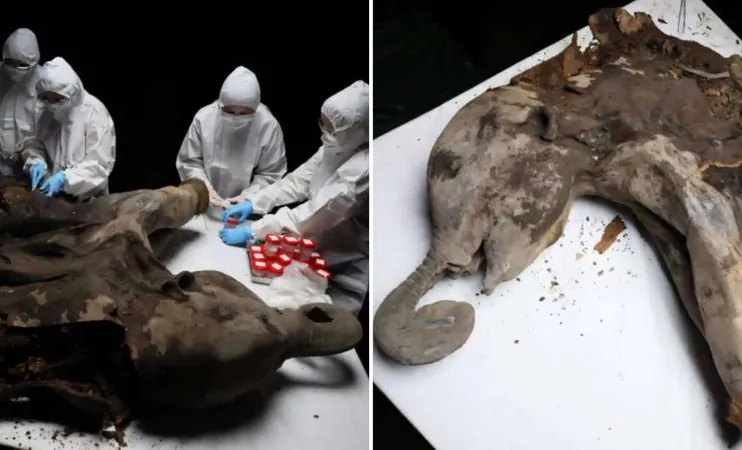
Scientists Make Groundbreaking Discovery with 130,000-Year-Old Baby Mammoth Yana as Permafrost Melts
2025-04-05
Author: Chun
Preserved to Perfection
Weighing approximately 180 kilograms (400 pounds) and measuring about 2 meters in length, Yana’s condition exceeds scientists' expectations. Her grayish-brown skin, patches of reddish hair, and recognizable features, including eyes and a wrinkled trunk, strikingly resemble those of modern elephants. “Many organs and tissues are very well preserved,” stated Artemy Goncharov from the Institute of Experimental Medicine in St. Petersburg.
The dissection team, clad in sterile bodysuits, masks, and goggles, meticulously samples Yana’s stomach, colon, and other organs to identify ancient plant spores, bacteria, and genetic material, all of which could reveal secrets about Ice Age ecosystems. Notably, her milk tusks suggest she was about one year old at the time of her death, providing context for her early life.
Peering Into Prehistoric Microbiomes
Perhaps Yana's most significant contribution to science lies in her microbiome. Researchers are delving into intestinal and vaginal bacteria to uncover the types of microorganisms that cohabited with large Ice Age mammals. “We want to explore her vaginal microbiome to better understand the microbial life that existed alongside her,” explained Artyom Nedoluzhko, head of the Paleogenomics Laboratory at the European University at St. Petersburg.
This groundbreaking research may illuminate the evolutionary history of bacteria, enabling comparisons between ancient strains and those present in contemporary human and animal species.
An Alarming Backdrop: Climate Change and Thawing Permafrost
The stunning discoveries surrounding Yana come with a stern warning about the implications of climate change. Her preservation was only made possible through melting permafrost—a phenomenon hastened by global warming. This thawing process raises concerns amongst scientists about the potential release of ancient pathogens that have been dormant in frozen soil for tens of thousands of years.
“There are suggestions that pathogenic microorganisms may be preserved within the permafrost,” Goncharov cautioned. “As it thaws, these microorganisms could contaminate water sources, plants, and might even pose risks to animals and humans alike.”
The intersection of mammoth research with public health, microbiology, and climate science highlights a crucial point: understanding our past is imperative for safeguarding our future.
Glances into a Pre-Human World
Yana roamed a landscape long before modern humans inhabited Siberia, which was settled only about 28,000 to 32,000 years ago. She thrived amidst grasslands and megafauna, offering a perspective on ecosystems that bear no resemblance to today’s world.
“This necropsy is a unique chance to peer into the Earth’s past,” Goncharov remarked, describing the endeavor as both an enlightening journey and an urgent race against time as rising global temperatures continue to unearth ancient—but potentially hazardous—remains.
Stay Tuned!
As the climate crisis progresses, the findings from Yana’s study may not only reveal secrets from the Ice Age but also impact our understanding of the threats posed by climate change today. Scientists are urging further exploration as the race to comprehend the implications of thawing permafrost heats up!




 Brasil (PT)
Brasil (PT)
 Canada (EN)
Canada (EN)
 Chile (ES)
Chile (ES)
 Česko (CS)
Česko (CS)
 대한민국 (KO)
대한민국 (KO)
 España (ES)
España (ES)
 France (FR)
France (FR)
 Hong Kong (EN)
Hong Kong (EN)
 Italia (IT)
Italia (IT)
 日本 (JA)
日本 (JA)
 Magyarország (HU)
Magyarország (HU)
 Norge (NO)
Norge (NO)
 Polska (PL)
Polska (PL)
 Schweiz (DE)
Schweiz (DE)
 Singapore (EN)
Singapore (EN)
 Sverige (SV)
Sverige (SV)
 Suomi (FI)
Suomi (FI)
 Türkiye (TR)
Türkiye (TR)
 الإمارات العربية المتحدة (AR)
الإمارات العربية المتحدة (AR)